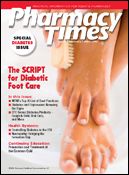Protease Inhibitors and PPIs
Proton pump inhibitors are potent inhibitors of gastric acid secretion; their interactions with protease inhibitors are discussed here.
Drs. Horn and Hansten are bothprofessors of pharmacy at the Universityof Washington School of Pharmacy.For an electronic version of this article,including references if any, visitwww.hanstenandhorn.com.
Proton pump inhibitors (PPIs) arethe most potent inhibitors of gastricacid secretion currently available.They have become the treatmentof choice for acid-related upper gastrointestinal(GI) symptoms and diseases.In addition to the classical indicationsfor PPI therapy, some drug regimensproduce a high incidence of GI sideeffects. For example, in a survey of HIVpatients receiving highly active antiretroviraltherapy, a majority reportedusing some sort of acid suppressivetherapy including antacids, histamine-2receptor antagonists (H2RAs), and PPIsfor heartburn and gastroesophagealreflux disease.1 Thus, the potential fordrug interactions between antiretroviraldrugs and acid suppressive therapyis large. In this review, we will focuson the interactions between proteaseinhibitors and PPIs.
Effect of PPIs on Plasma Concentrations of Protease Inhibitors
Protease Inhibitor
Mean Change in AUC (%)
Atazanavir (Reyataz)
Decrease 76-98
Darunavir (Prezista)
Increase 4
Fosamprenavir (Lexiva)
Decrease 2-9
Indinavir (Crixivan)
Decrease 10-50
Lopinavir/Ritonavir (Kaletra)
None
Nelfinavir (Viracept)
Decrease 36
Ritonavir (Norvir)
Decrease 0-17
Saquinavir/Ritonavir (Fortovase)
Increase 54-82
Tipranavir (Aptivus)
None
AUC = area under the plasma concentration-time curve;
PPIs = proton pump inhibitors.
Atazanavir appears to be most sensitiveto pH changes caused by PPIs.Studies have noted marked reductionsin atazanavir area under the plasmaconcentration-time curve (AUC) whenit is administered with PPIs includingomeprazole and lansoprazole.2-4Atazanavir minimum plasma concentrationsin patients treated with PPIshave been reported to be unaffected byconcomitant PPI use.5 The differencesin these reports may be due to differentsubject types, PPI doses, and smallsample sizes. Pending further data, PPIsshould be avoided in patients takingatazanavir.
Fosamprenavir is a prodrug for amprenavir.Its solubility is reduced whenthe pH exceeds 3.3. One might expectPPIs would reduce its absorption.Studies where fosamprenavir is administeredsimultaneously with esomeprazole,however, did not detect a significantreduction in amprenavir plasmaconcentrations. It may be that administeringthe fosamprenavir at the nadir ofthe PPI's acid-suppressing action limitsthe potential effect. It is common forthe gastric pH to drop below 3 duringthe morning before the effects of thePPI are maximized. It is noteworthy thatH2RAs produce a greater (30%) reductionin amprenavir concentrations, perhapsdue to their more rapid effecton gastric pH after dosing. PPIs mayproduce a larger effect on fosamprenavir'sabsorption under different dosingconditions.
Omeprazole has been reported toreduce the plasma concentration of indinavirby up to 50%.6,7 Increasing thedose of omeprazole from 20 to 40 mgdaily increased the magnitude of thereduction.7 Nelfinavir appears to beaffected to a slightly lesser extent.8
Whereas darunavir, lopinavir, ritonavir,and tipranavir appear to be minimallyaffected by PPI administration,the plasma concentration of saquinavirhas been noted to increase significantlyduring concurrent PPI dosing.9,10 Theadministration of omeprazole 2 hoursprior to the saquinavir dose produceda similar increase in the AUC (67%vs 54%), compared with simultaneousadministration.10
It appears that the effects of PPIs onprotease inhibitors (both decreased andincreased plasma concentrations) arebased on changes in gastric pH. Theeffects of H2RAs typically mirror thechanges noted with PPIs. Unfortunately,many of the studies did not measure gastricpH or control for differences in PPImetabolism due to CYP2C19 genotype.The clinical significance of the reportedchanges in protease inhibitor plasmaconcentrations remains to be defined.Reduced efficacy or the development ofresistant strains of HIV may result fromlowered plasma concentrations.
Due to the limited number of publishedstudies often involving smallnumbers of healthy subjects, the meanchanges in protease inhibitor concentrationshould be used only as a roughestimate of the magnitude of effect in aspecific patient. It is probable that PPIinducedchanges in protease inhibitorAUC will vary by specific PPI, its dosageregimen, pharmacogenetics, and apatient's underlying diseases. Patientstaking protease inhibitors should becounseled regarding the use of acidreducingdrugs, including those availableover the counter. If acid-reducingdrugs are used, patients should be monitoredfor changes in their response toantiviral therapy.
References
- Luber A, Garg V, Gharakhanian S, Vertex HIV Program Team. Survey of medication used by HIV-infected patients that affected gastrointestinal (GI) acidity and potential for negative drug interactions with HAART. 7th International Congress on Drug Therapy in HIV Infection. Glasgow, UK; 2004 [abstract P294].
- Agarwala S, Gray K, Eley T, Wang Y, Hughes E, Grasela D. Pharmacokinetic interaction between atazanavir and omeprazole in healthy subjects. 3rd International AIDS Society Conference on HIV Pathogenesis and Treatment. Rio de Janeiro, Brazil; 2005 [abstract WePe3.3C08].
- Agarwala S, Gray K, Wang Y, Grasela D. Pharmacokinetic effect of omeprazole on atazanavir co-administered with ritonavir in healthy subjects. 12th Conference on Retroviruses and Opportunistic Infections. Boston, MA; 2005 [abstract no. 658].
- Tomilo DL, Smith PF, Ogundele AB, et al. Inhibition of atazanavir oral absorption by lansoprazole gastric acid suppression in healthy volunteers. Pharmacotherapy. 2006;26:341-346.
- Guiard-Schmid JB, Poirier JM, Bonnard P, et al. Proton pump inhibitors do not reduce atazanavir concentrations in HIV-infected patients treated with ritonavir-boosted atazanavir [letter]. AIDS. 2005;19(16):1937-1938.
- Burger DM, Hugen PW, Kroon FP, et al. Pharmacokinetic interaction between the proton pump inhibitor omeprazole and the HIV protease inhibitor indinavir. AIDS. 1998;12(15):2080-2082.
- Tappouni HL, Rublein JC, Donovan BJ, et al. Effect of omeprazole on the plasma concentrations of indinavir when administered alone and in combination with ritonavir. Am J Health Syst Pharm. 2008;65(5):422-428.
- Fang AF, Bharat DD, LaBadie RR, Crownover PH, Hewlett D, Glue PW. Significant decrease in nelfinavir systemic exposure after omeprazole coadministration in healthy subjects. Pharmacotherapy. 2008;28(1):42-50.
- Winston A, Back D, Fletcher C, et al. Effect of omeprazole on the pharmacokinetics of saquinavir-500 mg formulation with ritonavir in healthy male and female volunteers. AIDS. 2006;20(10):1401-1406.
- Singh K, Dickinson L, Chaikan A, et al. Pharmacokinetics and safety of saquinavir/ritonavir and omeprazole in HIV-infected subjects. Clin Pharmacol Ther. 2008;83(6):867-872.

